One of the newest buildings on campus, Discovery building has many unique features - both safety- and research-related.
Discovery building is connected to Innovation building. This means if a building alarm sounds, occupants from BOTH buildings must evacuate immediately.
Chemical Fume Hoods
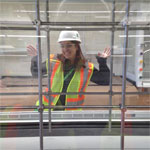
Ensure that your chemical fume hood sash is completely closed when not in use and at the end of every day.
In Discovery Teaching Labs, the chemical fume hoods have glass sides and a rear wall so that Teaching Assistants (TAs) can see what students are doing at all times.
To prevent fire from spreading through chemical fume hood ductwork, there are smoke detectors in the fume hood ducts. These are designed to shut down the building ventilation and set off the fire alarms so that occupants clear the building immediately. Burlington Fire Dept and UVM Police Services is immediately alerted when the building fire alarms sounds. These detectors can be triggered by fume or fog as well.
Airflow Monitors/Alarm
 *The airflow for safe operations in STEM Discovery fume hoods are set to be 80 lfpm. Always move the sash slowly up or down so as not to disturb the airlfow or draw hazardous vapors out of the fume hood.
*The airflow for safe operations in STEM Discovery fume hoods are set to be 80 lfpm. Always move the sash slowly up or down so as not to disturb the airlfow or draw hazardous vapors out of the fume hood.
The fume hoods are able to be held open completely - ONLY when setting something up in the hood or for cleaning purposes. If the fume hood sash is left in the full open position too long, the fume hood alarm will go off. Remember, leaving a fume hood sash open also wastes energy.
The user has a limited amount of time to finish what they are doing before the alarm will appear on a Physical Plant control screen. *Muting the alarm will not make the notification disappear.* Always lower the sash when you are done putting equipment into or taking equipment out of the chemical fume hood.
The MAX height to use the fume hood safely is set at 18 inches. Use the fume hood with the sash at 18 inches OR LOWER!
When you lower the sash, the airflow in the hood will re-set to a safe and set amount. If the alarm continues to go off, Physical Plant personnel will respond to see what is happening.
*Click image to enlarge.
Chemical Fume Hood Purge Buttons
These are located on the fume hood monitor. If there is a chemical spill or strong odor in the hood or lab, the purge button will increase airflow inside the hood to exhaust more air out of the hood and the lab.
Shut the Sash Program
Fume hoods are one of the most energy intensive types of equipment in a laboratory. Significant energy savings can be achieved by keeping them closed when not in use.
Natural Gas Use
Blue Natural Gas Knob on Teaching Lab Benches
 To operate, you must push down THEN turn knob to turn on.
To operate, you must push down THEN turn knob to turn on.
After using natural gas in a teaching lab, make sure to check the individual spigots to make sure the gas has been turned off completely.
Point-of-Use Regulators
These are used to regulate natural gas to proper psi at "point of use" in lab. DO not purchase your own point of use regulator.
Place a PLANON Work Order through your administrative assistant to have one installed by Physical Plant personnel.
Red Emergency Power Off (EPO) Button
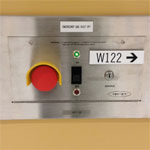 All of the emergency power off (EPO) buttons are located in hallway on a panel near the lab doors. EPO buttons only shuts off the natural gas to a particular lab as needed during an emergency.
All of the emergency power off (EPO) buttons are located in hallway on a panel near the lab doors. EPO buttons only shuts off the natural gas to a particular lab as needed during an emergency.
To use the EPO, simply hit the big red button. In order for the natural gas to be turned on again, Physical Plant must reset it at the panel.
If you want to make sure your lab will have natural gas, check the panel. If the green light is the only light lit up, natural gas should be flowing to your lab.
There are two areas in Discovery that one lab's panel is directly above the neighboring lab's panel. The green tape denotes which is which: green tape on the left part of the panel is for the lab to the left, green tape on the right part of the panel is for the lab to the right.
Compressed Nitrogen Gas Plumbed into Labs
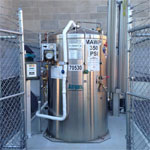 Compressed nitrogen gas is supplied to labs in Discovery from an Aigas bulk tank on the north side of the building. The pressure to individual labs is set by the valve from the bulk tank. Point-of-use regulators are able to further regulate the pressure. These are used to regulate the pressure to the proper psi (pounds per square inch) at "point of use" in the lab.
Compressed nitrogen gas is supplied to labs in Discovery from an Aigas bulk tank on the north side of the building. The pressure to individual labs is set by the valve from the bulk tank. Point-of-use regulators are able to further regulate the pressure. These are used to regulate the pressure to the proper psi (pounds per square inch) at "point of use" in the lab.
Do NOT purchase or install your own point-of-use regulator.
Place a PLANON Work Order through your administrative assistant to have one installed by Physical Plant personnel.
House Vacuum System
Information coming soon!
GF Signet Flow Monitor
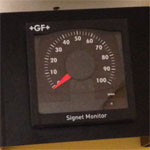 These monitors are found above some lab doors in the hallways. These measure the conductivity of the RO (reverse osmosis) water.
These monitors are found above some lab doors in the hallways. These measure the conductivity of the RO (reverse osmosis) water.
Fire Protection
Fire Doors
Every lab door in Discovery is a fire door and must be kept closed at all times. A door may be held open temporarily in order to bring large equipment into, or out of, the lab. Make sure to allow the door to close completely after the move is complete.
Magnetic Holders/Release
Some rooms have magnetic holders attached to the doors. This allows the door to be held open, and in the event of a fire or power outage, the door will automatically shut.
Stairwell Barricades
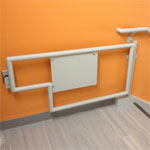 In the event of a fire, make sure to use the stairs to get to one of the two main exits (2nd floor, west side and 1st floor, north side). The stairwell to the basement (at the north end of the building) has a barricade that will release to block off the stairs. When coming up the stairs from the basement, the barricade swings out. When coming down the stairs from the first floor, the barricade will block the stairs to avoid anyone entering the basement accidentally. There is another barricade in the stairwell to the first floor at the south end of the building. This serves to avoid anyone going away from the exit available on the second floor.
In the event of a fire, make sure to use the stairs to get to one of the two main exits (2nd floor, west side and 1st floor, north side). The stairwell to the basement (at the north end of the building) has a barricade that will release to block off the stairs. When coming up the stairs from the basement, the barricade swings out. When coming down the stairs from the first floor, the barricade will block the stairs to avoid anyone entering the basement accidentally. There is another barricade in the stairwell to the first floor at the south end of the building. This serves to avoid anyone going away from the exit available on the second floor.
Fire/Emergency Strobes (wall-mounted and ceiling-mounted)
 These strobes will flash and a recorded message will come over a loud speaker. Message will tell occupants to evacuate the building. It will also activate when there is a manual fire alarm pulled to notify occupants to evacuate the building.
These strobes will flash and a recorded message will come over a loud speaker. Message will tell occupants to evacuate the building. It will also activate when there is a manual fire alarm pulled to notify occupants to evacuate the building.
This is a critical fire alarm notification. LISTEN to the announcement and proceed accordingly. The message will most likely ask you to evacuate but LISTEN to the message in case there are incident-specific instructions.
Emergency Lab Equipment
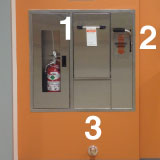 Emergency Stations in All Laboratories
Emergency Stations in All Laboratories
- Pull down on handle to activate eye wash
- Pull down on handle to activate safety shower
- Eye wash is designed to drain on the lab floor. Do not worry about getting the floor wet - take care of your eyes, first and foremost.
Spill Response Center: in Chemistry TEACHING LABS only
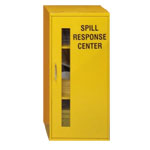 Inside of this Spill Response Center, you will find the following supplies:
Inside of this Spill Response Center, you will find the following supplies:
- Chemically inert spill pads - These are the same spill pads that are provided in spill kits. They can be used to soak up any small liquid chemical spills (< 1 L) in the lab. For spills greater than 1 L, call Service Operations Support (656-2560, ext. 1) to contact Risk Mgmt. and Safety to help with the cleanup.
- Sodium bicarbonate - This can be used to neutralize any acid spills.
- Dustpan and brush - There should be two sets of dust pans and brushes in each teaching lab, and one set should be located in the spill response center. They can be used together to clean up broken glass and solid materials.
- Zip-top baggies - Any debris generated while cleaning up a spill should be collected in a waste container. Collect all debris in the zip-top baggies, and tag as waste.
- Waste tags - Make sure to tag the lab's waste at the end of each teaching week, no later than Thursday night. Any waste that is generated during a spill cleanup must also be tagged for pickup.
If any of the materials in the spill response center are used, make sure they are re-stocked for the next TA. Again, any waste generated should be tagged for pickup.
Laser Labs
Obey Signage and Curtains
 Laser labs – curtain
Laser labs – curtain
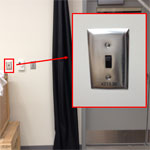 Laser labs - EPO
Laser labs - EPO
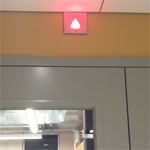 Laser labs – light in use
Laser labs – light in use
Building Hours: Occupied and Unoccupied
During "Occupied" hours (6am - 8pm) the building will be unlocked.
UNoccupied hours are from 8pm until 6am. Faculty, staff, and students will need to use CatCard panels to gain access to the building. Regardless of if the building is in occupied or unoccupied mode, all interior doors should remain locked.
Communication Panels
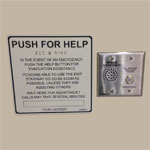 These communication panels ONLY supposed to be for people with mobility issues who cannot use the stairs during an evacuation, to wait there and call for help. These communication panels are located in STEM Discovery on the basement, 2nd, 3rd, and 4th floors by the south elevator. There is a panel located in the penthouse near the central elevator. NOTE: There is currently no communication panel on the 1st floor south elevator.
These communication panels ONLY supposed to be for people with mobility issues who cannot use the stairs during an evacuation, to wait there and call for help. These communication panels are located in STEM Discovery on the basement, 2nd, 3rd, and 4th floors by the south elevator. There is a panel located in the penthouse near the central elevator. NOTE: There is currently no communication panel on the 1st floor south elevator.
If you have mobility issues and were stranded and used it to call for help, the call will go to a panel next to the main fire alarm panel in the 2nd floor west (main) entry. Calls will only be answered if the Burlington Fire Department is already at the scene in the lobby at the main fire alarm panel.
Remember it is best to first call UVM Police at 802-656-FIRE (3473) if you need immediate assistance.
Emergency Generator Information
The emergency generator in Discovery building provides power to the following utilities:
- Building air handling systems (supply and exhaust),
- Fire detection and suppression systems,
- Emergency lighting,
- Elevators (return to ground floor),
- Red outlets,
- Plumbing drain systems (lab and domestic), and
- RO/DI water system (though this system may require resetting after a power transfer unless an uninterrupted power supply (UPS) is installed).
Emergency power is NOT supplied to central vacuum or compressed air systems (serving Discovery and Votey). The powered fan filters serving W006 (clean room) are not on the emergency power system, but there is still supply air serving this space. Even though supply and exhaust will be operational, if the electrical power becomes unreliable, lab operations should be stabilized and/or ceased as soon as possible.
The building nitrogen system will continue to operate during an electrical (power) outage.
Researchers should respond to loss of power in the building by stabilizing, ceasing, and making safe all hazardous operations and materials until restoration of main and backup power.
How does backup power work in Discovery?
A power transfer to the emergency generator takes about 10 seconds. It then takes about 5 minutes for all of the air handling fans to return to full operation. During this time there should be no depressurization issues in the building or labs, but the hoods will be in alarm until the fans return to their setpoint.
If your fume hood goes into alarm for any reason, close the sash as soon as possible. Loss of power does not automatically trigger a room or building evacuation provided the emergency generator responds and ventilation is restored.